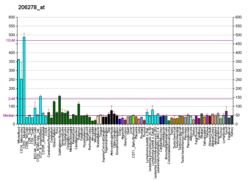Top Qs
Timeline
Chat
Perspective
Platelet-activating factor receptor
Protein-coding gene in the species Homo sapiens From Wikipedia, the free encyclopedia
Remove ads
The platelet-activating factor receptor (PAF-R) is a G-protein coupled receptor which binds platelet-activating factor.[5][6] It is encoded in the human by the PTAFR gene.
The PAF receptor shows structural characteristics of the rhodopsin (MIM 180380) gene family and binds platelet-activating factor (PAF). PAF is a phospholipid (1-0-alkyl-2-acetyl-sn-glycero-3-phosphorylcholine) that has been implicated as a mediator in diverse pathologic processes, such as allergy, asthma, septic shock, arterial thrombosis, and inflammatory processes.[supplied by OMIM][7] Its pathogenetic role in chronic kidney failure has also been reported recently.[8]
Remove ads
Ligands
Agonists
Antagonists
- Apafant (WEB-2086)
- Israpafant (Y-24180)
- Lexipafant
- Rupatadine
References
Further reading
External links
Wikiwand - on
Seamless Wikipedia browsing. On steroids.
Remove ads






